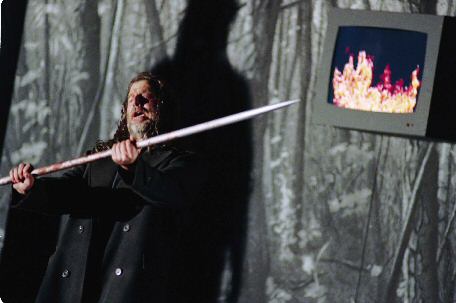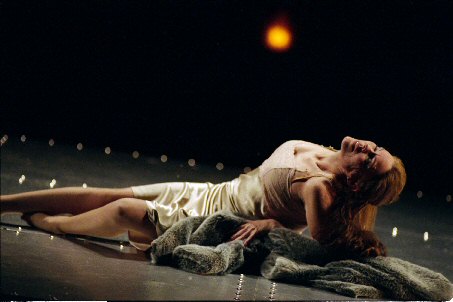|
Seen and
Heard Opera Review
Richard Wagner, Siegfried,
Soloists and Orchestra of English National Opera, Paul Daniel (cond),
Coliseum, 6th November 2004 (MB)
Siegfried throws up so many challenges –
orchestrally and vocally - that it is easy to distort its on stage
dramatic structure. Musically, this opera contains some of the starkest
and darkest music of the cycle (take, for example, the enormously
powerful prelude to Act III); any on stage action can seemingly detract
from the musical inspiration that defines it. This was precisely what
happened as the curtain went up on Act III – with an eruption
of applause that undermined the context of the scene between the Wanderer
and Erda. The blazing anger in both trumpets and trombones (and a
thrilling thunder machine) seemed somewhat underwhelming besides the
scene of Erda in a nursing home, surrounded by Norms sat in vast armchairs
knitting and drinking tea whilst watching on screen flames prematurely
engulfing Valhalla (a less than subtle attempt to capture our all
too human obsession, post 9/11, to watch disaster unfolding before
our eyes).

Similarly, one almost despaired at the forging song at the close of
Act I – accompanied as it is by music of breathtaking heaviness
in its brass chords – which showed Siegfried fashioning Nothung
with the minimal of physical effort. Rather than the labour of hammer
against anvil, the colossal effort required to finally forge the sword
and raise it aloft was accompanied by stage direction that created
the illusion of magic, with its static, flaring flashes of splintered
light, billows of steam and fiery-red background, which swamped Siegfried
as he pulled the sword from beneath the stage, symptomatic of production
values that seemed intent on diminishing the musical and over-egging
the dramatic into almost separate operatic entities.
These were disappointing moments, but so much else in this production
was outstandingly visualised, even if the singing remained uneven.
It was hardly surprising, given Phyllida Lloyd’s and Richard
Hudson’s domesticated Gods and mortals in Rhinegold
and The Valkyries, that Siegfried should open with
Mime’s hut viewed as an image of Faustian gloom. An old sofa,
cut out pictures pasted onto the walls, a bunk bed, a dirty sink (and
enough food to feed an army) made the Mime/Siegfried relationship
seem spellbindingly normal. When Siegfried entered (bear in tow) it
was as if a young, teenage skater had accidentally popped up on stage:
with his baseball cap and baggy jeans, Richard Berkeley-Steele made
a decent stab at knocking 20 years off his age, and this only got
more convincing as he toyed around with battery operated jeeps, listened
to music on a Walkman and read magazines in bed. This may well be
the most ‘teenage’ Siegfried I have seen on stage. Yet,
Berkeley-Steele, if not always resplendent of tone, had a youthfulness
to his voice that matched his impetuosity on stage, a more than decent
contrast to John Graham-Hall’s Mime, acted not only with slippery
craftsmanship, but sung with characterful precision throughout. Here
at least both singers moved with the orchestration: Siegfried quietly
lyrical, Mime psychologically dark and sombre (and in his final Act
II scene bordering on the demented). As in Valkyrie, Robert
Hayward’s Wanderer had vocal authority and a hefty tone, even
if one missed some warmth to his phrasing (but do we really feel this
singer’s presence when Wagner alludes to him through the majesty
of his orchestration?)

Gerard O’Connor’s tattooed Fafner remains an imposing
creation and is splendidly sung. If the dragon-like breathiness of
the orchestral prelude to Act II didn’t quite prepare us for
subsequent amplification of his voice, it was overshadowed by Lloyd’s
and Hudson’s skilful use of lighting to convey his physical
presence. Emerging from his bath (a recurring image in this cycle,
just as fire extinguishers are) – and growing ever taller as
he did so – his pre-destined death at the hands of Siegfried
nevertheless seemed to have an echo of menace about it. And here we
got the first coup of this production: stumbling on stage, bloodied
and covered in plastic sheeting, Fafner was all but eclipsed by Berkeley-Steel’s
majestically introspective Siegfried: vocally impressive, we get the
first hints of Siegfried as hero (as opposed to anti-hero) as power
finally seems to make us to warm to him. It’s a short-lived
moment, however, because the appearance of the Woodbird (a rather
squally Sarah Tynan) on a scooter throws us back to the image of the
hip-skater Siegfried, something that robs what has preceded it of
any long-term significance. Tynan’s voice improved markedly
during the opening of Act III (only to be overshadowed by the richly
toned Erda of Patricia Bardon) but a kind of Keystone-cop type farce
bloodied events as Siegfried petulantly overturned chairs, throwing
the Norms and Erda to the ground in the process. Suddenly, the anti-hero
was before us again.
But the depth of Berkeley-Steele’s characterisation of Siegfried
is that he is always greater than the sum of his parts. Thus, when
he happens upon Brünnhilde (Kathleen Broderick) after breaking
through the curtain of fire he is seemingly heroic, physically towering
and simply unaware of fear as he seeks to wake her from sleep. If
his ascent to the summit is perhaps more an ascent from below, in
a moment of startling beauty, we see the shadow of Brünnhilde
cocooned like an Egyptian mummy; Siegfried’s prize to her as
they embrace is for her to throw off the shackles of her imprisonment
and make her blossom like a newly born butterfly. Here the orchestra
under Daniel excelled themselves: radiant, high violins were as pure
of tone as you could have wished for, rekindled like oxygen breathing
life into fire, replacing the almost endless subterranean orchestration
that preceded it. That it should actually have been noticed at all
is to Daniel’s and the orchestra’s credit. The radiance
that develops after this moment was taken by both Broderick and Berkeley-Steele
to ignite vocal as well as physical passion. It was a perfect summation
of their fusion of ecstatic, lyrical affirmation, and a fitting conclusion
to this production.

Siegfried showed Lloyd and Hudson more confident in their
vision of this ongoing cycle, and that confidence is replicated in
the orchestra pit as well. The ENO orchestra – especially the
brass – were both magnificent and resplendent and Paul Daniel
showed less unevenness in his grasp over the score than he has done
in earlier parts of this Ring. Indeed, this production is almost a
triumph.
Marc Bridle
Picture credits: John Graham-Hall
(Mime), Richard Berkeley-Steele (Siegfried), Robert Hayward (Wanderer),
Kathleen Broderick (Brünnhilde) – photographer, Neil Libbert.
Further Listening:
Richard Wagner, Siegfried, Soloists, Bayreuth Festival Orchestra,
Herbert von Karajan, MYTO HO55
Back to the Top
Back
to the Index Page
|





